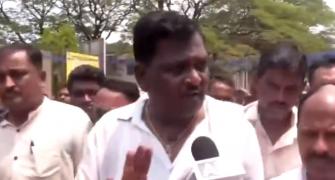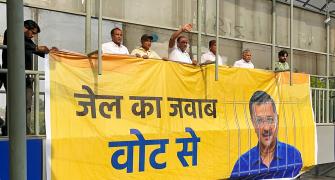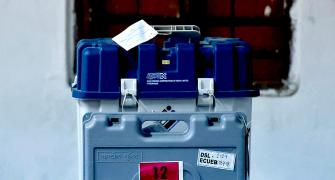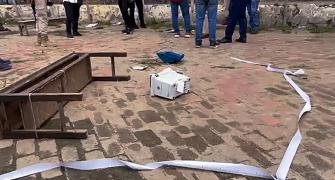Intelligence Bureau sleuths say the menace of fake currency is on the rise and there is a specific information that this money is being used extensively for terror operations.
IB sources told this correspondent earlier that Pakistan's Inter Services Intelligence raises Rs 1,800 crore (Rs 18 billion) annually to fund terror operations and that a major chunk of this amount comes in through fake currency rackets.
IB officials say Rs 30 lakh (Rs 3 million) of the Rs 50 lakh (Rs 5 million) spent on the attack on the Indian Institute of Science, Bangalore, in December 2005 was obtained through the fake currency racket.
Investigating agencies claim that the amount of fake currency in India is a shocking Rs 170,000 crore (Rs 17 trillion).
Reserve Bank of India officials dispute this figure and say that as on July 2008, the total currency available with the Indian public was Rs 603,000 crore (Rs 63 trillion) and if what the IB is saying is true, then it would mean that 28 per cent of the currency in the country is fake.
The fact that fake currency is being generated with the ISI's blessings in Pakistan is no secret. IB dossiers suggest that the notes are printed in Pakistan and then transferred to Dubai. In Dubai, the money is collected by hawala operators and dumped in India.
All fake currency reaches Maharashtra first, according to investigators. This is because it is familiar terrain for fugitive gangster Dawood Ibrahim. His proximity with the ISI grew after he took over responsibility of pumping fake currency into India.
IB officials say while Dawood controls most of this racket, Aftab Bhakti, originally from Mumbai, and Babu Gaithan, from Hyderabad, take care of operations in Dubai. The duo are in charge of collecting the money and then transporting it to India. This money is transported through individuals travelling between Dubai and India.
Labourers, who go to Dubai in search of employment, are the usual targets. When they return to India to visit relatives, they are lured with incentives to carry the fake currency. The notes are covered in carbon paper and stashed in suitcases and covered with perfume, clothes and other goodies. IB sleuths say there have been instances where notes have been packed in photographic albums.
While a large chunk of the fake currency is sent from Dubai, a sizeable amount of money also comes in through India's borders with Bangladesh and Pakistan.
Majid Bilal, Harkat-ul-Jihad-al Islami terrorist Shahid Bilal's brother, during his interrogation, said that Pakistani agencies had made it compulsory for terrorists to carry fake currency into India each time they crossed the border. He said the point men were based in Uttar Pradesh, Rajasthan, Andhra Pradesh and Maharashtra. The fake money is exchanged for original notes on a 2:1 basis. The money generated is then passed onto various terror networks in India to fund operations.
Majid mentioned that Rs 5 crore (Rs 50 million) was spent on last year's Hyderabad blasts and all this money was generated through the distribution of fake currency.
Both RBI and IB sources say it is difficult to differentiate between real and fake currency notes.
But an RBI official says there are prominent differences between the real and fake notes.
In a fake note, the security thread or the silver bromide and the logo are hazy. The three watermarks on each note -- the Ashoka Pillar, Mahatma Gandhi's image, denomination and the words RBI -- are not as prominent compared to original notes. In the fake currency, the sprinkled blue dots are not visible when seen through ultra violet light. Lastly, the superimposed digits are not visible when seen horizontally.
RBI officials, who have closely observed fake notes printed in Pakistan, say:
-
The distinctive numbers are smaller in size.
-
The alignment of series prefix are not in line when carefully examined.
-
Thick lettering is used to print the issuing authority's name.
-
Continuity of the security thread is not maintained.
-
Alignment of the register on the left hand side of the watermark is not proper.
-
Watermark on the left hand side bears a thicker image of Mahatma Gandhi whose eyes and spectacles are thicker in size.
-
Intaglio printing is absent.
-
Optical fibre marks are present when exposed to ultra violet light, but these are few when compared to genuine notes.
-
The security thread does not glow under ultra violet light.
-
The paper used is made of wood pulp while compared to the security paper, cotton and special ink used in the manufacture of the notes by the RBI.
There is a growing concern that more and more fake notes make their way into the Indian banking system. A bank official, speaking on condition of anonymity, explained that there are two ways in which such fake currency reaches banks.
Business establishments are targetted by the counterfeiters and the fake notes passed on to such entities in the course of business. The unsuspecting establishments innocently deposit the fake notes in the bank.
In some cases the perpetrators of the racket themselves deposit the fake cash, usually during peak hours and during busy periods like the festive season. Bank tellers, who are under tremendous pressure at these times, accept the notes without authenticating them.
While the RBI says that banks ought to be more careful and should have a fool-proof screening process, bankers say it is extremely difficult to keep a tab on every currency note.
Although the fake currency racket is a huge threat to the Indian economy, the conviction rate is a mere 6 per cent across the country. Explains R G Sadashiv Reddy, a senior advocate, "Such cases are incomplete unless the person, who originally floated the note, is caught. Usually, the case comes to light only when the fake currency has changed hands several times and there is no point in convicting a man who was last in possession of the notes."
Another hindrance is the law relating to such cases. An amendment to the Criminal Procedure Code now seeks to resolve this problem. This amendment proposes for the inclusion of more scientific experts to give evidence in cases relating to fake currency notes, in addition to officers of the Indian Mint or India Security Press, Nashik. Section 292 of the Criminal Procedure Code is proposed to be amended to enlarge the list of offices whose expert opinion on counterfeit currency can be considered as evidence.
By January 2009, the RBI proposes to withdraw all currency notes printed from 1996 and 2000. The RBI says that counterfeit notes are largely in the 1996 and 2000 series and hence it would be best to withdraw this series and introduce a new series of currency notes. The RBI says the new series will have enhanced security features. RBI officials, while understandably refusing to divulge the features, say these notes would be hard to copy.
The Central Bureau of Investigation plans to develop a national data bank of fake currency notes to help identify its origins.







